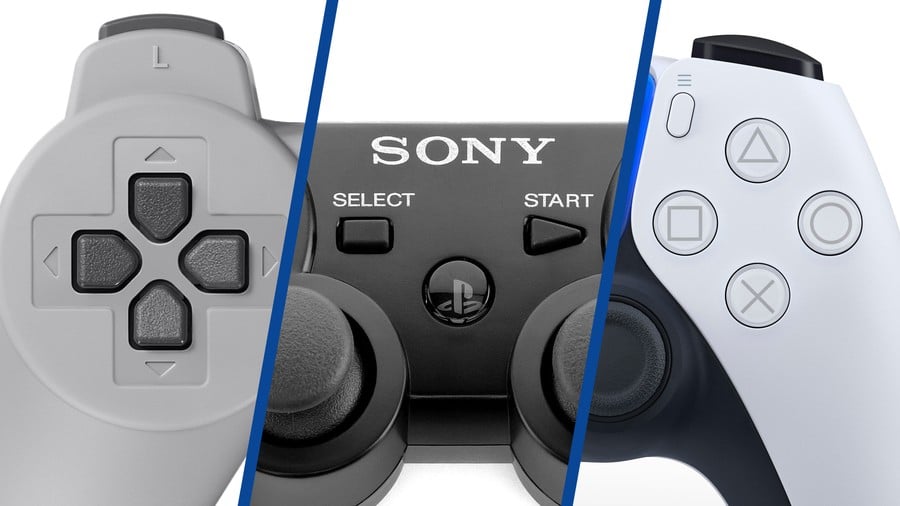
We're on the brink of the next generation, which will see PlayStation 5 step into the spotlight. Among other headline features such as a speedy SSD, 3D audio, and a seriously streamlined UI, Sony's new console will of course sport a revised controller. We now know this PS5 controller as DualSense, and it's the biggest departure Sony's ever made in terms of design. Even the DualShock name has been ditched. It still carries the fundamentals of a PlayStation pad, but if you compare the original to the upcoming device, the difference is night and day.
It's inspired us to take a look back at how the PlayStation controller has changed over the course of 25 years, and that's precisely what we'll be doing here. Let's dive into the history of Sony's iconic line of console controllers.
Subscribe to Push Square on YouTube166k
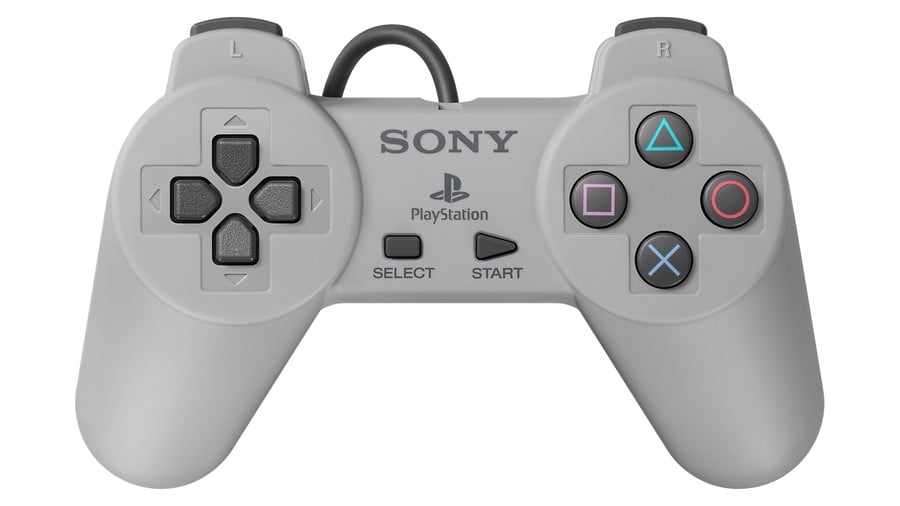
PS1 — Where It All Started
Let's begin at the beginning. The original PlayStation released in North America at the end of 1995, a time when gamers were accustomed to the SNES and the SEGA Genesis. Both machines had decent controllers, with the Super Nintendo's pad in particular a departure from the norm, sporting a D-pad, two shoulder buttons, four face buttons, and two central buttons. It's clear where Sony's initial inspiration came from, then, but it took things a step further for its very first controller.
The first attempt differentiated itself in a few ways. A unique D-pad design, four shoulder buttons emphasising the depth of 3D games, handles for better ergonomics and grip, and of course, the Triangle, Circle, X, and Square buttons — now synonymous with the brand. The reasoning behind the symbols is pretty sensible; initially, Circle and X were meant to represent yes and no, Triangle was supposed to denote a point of view, and Square was intended to be akin to a sheet of paper, or a menu. These original purposes have been lost as time's gone on, but the symbols themselves have remained throughout every iteration of the PlayStation pad.

It was only a couple of years later that Sony would introduce the world to the DualShock, an updated PS1 controller with two key additions — a pair of analog sticks and two rumble motors. The sticks have of course become a staple in controller design across the industry, allowing far better control in 3D games than the eight directions offered by the humble D-pad. The DualShock slowly replaced the stick-less model and became the de facto version moving forward. Games would come to rely on the twin sticks, with Ape Escape famously designed specifically around these inputs. Gamers have also come to expect rumble in controllers, and it's something that's stayed mostly the same in Sony's pads through the years.
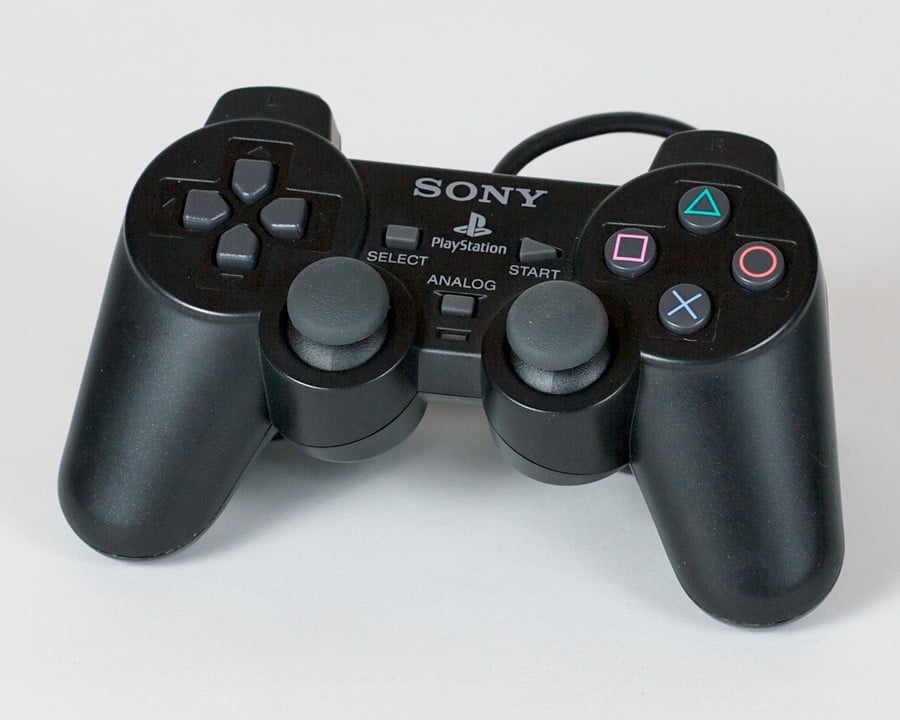
PS2 — Paint It Black
When it came to PlayStation 2, it seems Sony knew it had a winning pad. If it ain't broke, don't fix it, and at least in terms of exterior design, DualShock 2 is almost identical to its predecessor. The first noticeable difference is the change in colour scheme, swapping the light grey of the PS1 for a sleek black that would become the standard going forward. There were other refinements, though — the pad is lighter, and most inputs became analog, meaning buttons could respond differently depending on the pressure applied by the player.
Though the black colouring has become the default look, DualShock 2 introduced a rainbow of alternative colours, something Sony offers in future controllers too. Whichever colour was your favourite, it's likely this controller is one of the most used ever — PS2 is the best selling console of all time, after all.
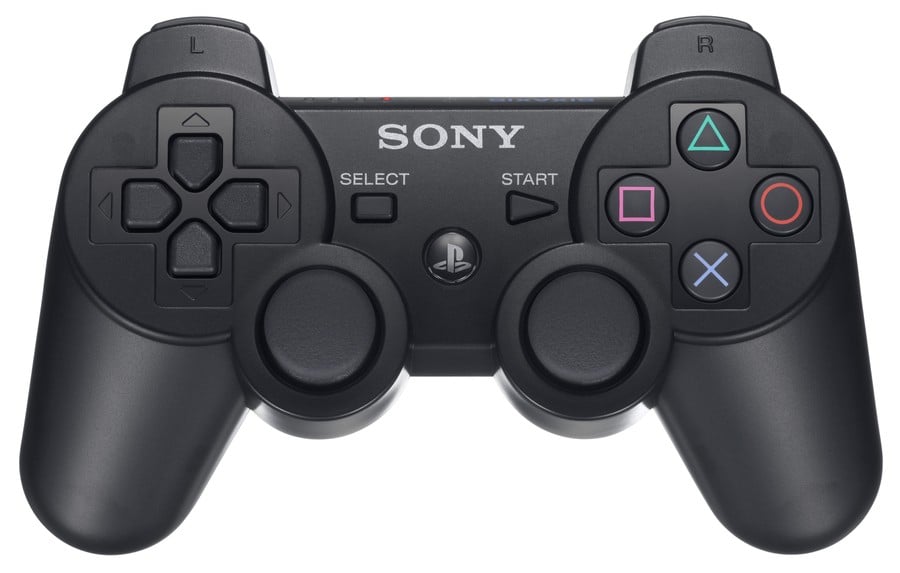
PS3 — Motion in the Ocean
Before we start, let's have a moment of recognition for a prototype PS3 pad that has become lovingly known as the Boomerang. It was a clear indication Sony was looking to make big changes, but this early design proved very unpopular online.
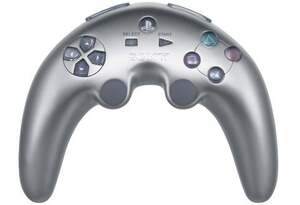
Sony reined it in for the final design, but it still experimented much more with player input. At launch, we had the SIXAXIS, which made a whole bunch of changes to the familiar pad. It retained all the buttons from previous iterations, but removed the rumble motors completely amid a legal battle between Sony and a company called Immersion. In its place was a gyro sensor, introducing PlayStation gamers to motion controls for the first time. It also included Bluetooth technology and a rechargeable battery, finally freeing users from wires, and made the L2 and R2 shoulder buttons much deeper in an attempt at triggers. Lastly, a central 'PS' button allowed players to turn on the PS3 wirelessly, access more options, and would eventually grant access to the console's menus mid-game.
Lots of important changes, then, but without vibration, something was missing from games, and the controller was considerably lighter than usual. A couple of years after PS3's launch, Sony won the legal fight over its rumble motors, and released the DualShock 3. Nearly identical to SIXAXIS, it finally added vibration back in, giving PS3 titles a new lease of life. While definitely an improvement, DualShock 3 still faced some criticism; the trigger buttons weren't ideal with their convex design, and the motion controls were largely ignored outside of first party games. However, all the new features introduced in this generation would go on to be implemented and improved in the next.
The PS3 era also saw the arrival of PlayStation Move controllers, inspired by the popularity of the Wii Remote. These bizarre wands didn't quite replicate the widespread love for Nintendo's unusual input, but Sony managed to find a new home for them much later with the advent of PlayStation VR.
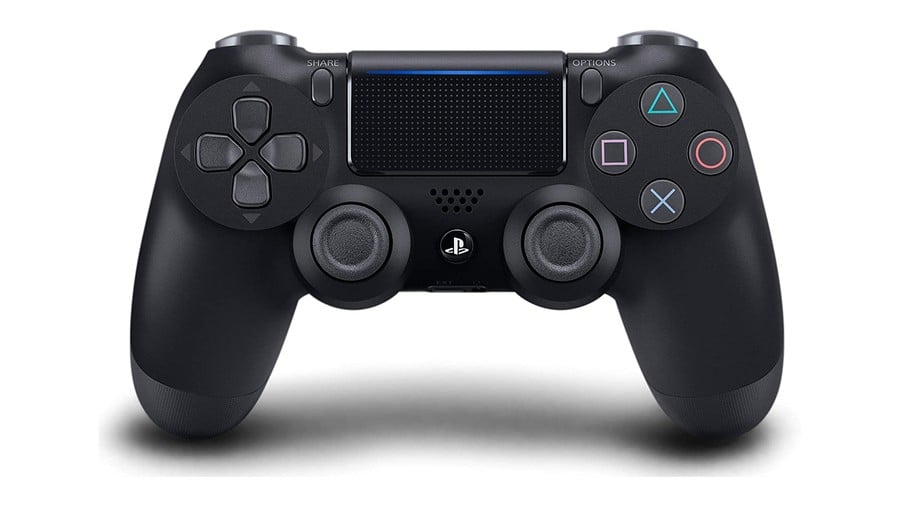
PS4 — A Touch of Change
Once again, for Sony's PS4 console, it decided to overhaul the design for its latest controller. DualShock 4 made some pretty hefty changes, and it's widely considered the best controller the company has made yet. It's overall a larger pad with much improved grips, while the basics are all present and correct. Unpopular as it was, gyro motion controls remained intact, and rumble was there from the start this time. The L2 and R2 buttons were greatly improved, curving up instead of down, and narrowed to make them more trigger-like.
There were much bigger changes, however. Front and centre sits a touch pad, a brand new input that allowed for touchscreen style controls. It's also clickable, effectively giving the DualShock 4 an extra couple of buttons. Speaking of buttons, Start and Select — present on every PlayStation pad since the start — were ditched in favour of Options and Share. Options largely acts on behalf of both Start and Select, while the Share button played into a more social side of gaming. This revolutionary new button allowed players to capture screenshots and gameplay footage to directly share online, and it's quickly become an industry standard input.
DualShock 4 also incorporated a tiny speaker, allowing some game audio to come through your controller, and a headphone jack, conveniently letting you plug your headset straight into the pad. Less popular is the light bar, which replaces the little red LEDs that used to indicate which player number you were. Big and bright, players would complain the blue beam would reflect on their TV screens. However, with the arrival of PlayStation VR, the light bar became a necessity for the tech to read the controller's position. It's still not a particularly popular part of the DualShock 4's design, but with the ability to dim the light or turn it off altogether, it wasn't a permanent issue. If you can also overlook a limited battery capacity, PS4's controller is still considered a fantastic bit of hardware.
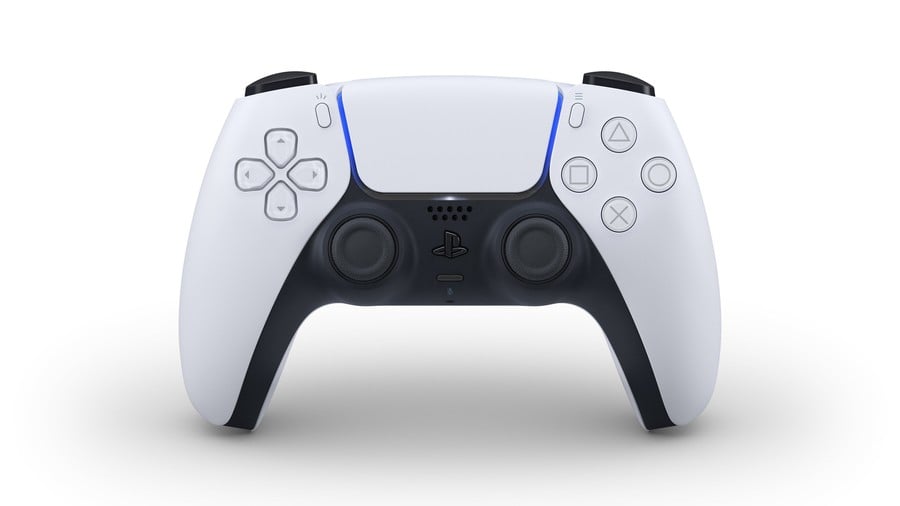
PS5 — Changes in Every DualSense
And so we come to what's next — the DualSense PS5 controller. The upcoming pad is another huge leap in terms of design, perhaps the biggest in the platform's history. The name should be a clue that Sony's not messing around here; we were all convinced the DualShock branding wouldn't be going anywhere, but PS5 is ushering in a totally revamped device with changes from the name up.
The exterior design is quite the departure from the norm. Larger than the DualShock 4, DualSense looks to have improved ergonomics while retaining all the key inputs. All the usual buttons are there, although the face buttons lose their classic colours in favour of a more uniform look. The colouring, meanwhile, is very different. We're so used to a solid black pad that the white frame is very striking, with only a small portion of the controller sporting a darker hue. The infamous light bar has moved to the front of the pad, surrounding the expanded touch pad to add a splash of blue. The Share button is now the Create button, and the PS button has evolved from a circular input to take the form of the emblem itself. Finally, an extra button at the bottom allows you to mute the new built-in microphone.
Speaking of new features, L2 and R2 are now adaptive triggers, meaning they can give the player a much wider variety of feeling. For instance, drawing a bow string back could make the trigger buttons tense up, and harder to press down. Then you have haptic feedback, which sees the classic rumble motors replaced with something more high tech. This will give players much more detailed sensations, allowing you to feel the difference between two surfaces, for instance.
The DualSense controller has proved exceedingly popular on social media, so the future looks bright for PS5's pad.
Looking back on PlayStation's major input devices, it's fascinating to compare what's changed over the years, as well as what's stayed the same. Fundamentally, every controller bares the same buttons, but Sony has gradually added more and more functionality. DualSense might look like a drastic change even compared with DualShock 4, but it's still absolutely a PlayStation design, building off the early successes of that original controller.
Which PlayStation pad is your personal favourite? Are you keen on the DualSense PS5 controller, or would you have preferred a more familiar look? Have your say in the comments below.





Comments 39
The PS5 controller is irrelevant because I'll be playing Elden Ring using nothing but frantic motion controls and increasingly angry voice commands, shouted through a mouthful of Pringles.
The DualSense looks crazy compared to its predecessors. Looks like a prop from a sci-fi movie at first glance. I think it's great, though.
I think my favourite controller is the DualShock 4. Pretty much the most comfortable controller I've ever used — only thing holding it back is the battery life (and the flaky analog sticks, but newer models don't have that problem).
What's the difference between the PS5 controller being announced, and a cow?
I sincerely doubt that the push square staff know how to milk a cow....
(Jk lads 😉)
@Johnnycide On the contrary — evidently, we know how to milk pretty much anything
Dualshock 4 is good but man, dualsense looks really sleek and futuristic, I like the dualtone design colour
Dualshock 4 is definitely my favorite but I'm really looking forward for the new one.
I especially feel with this design, they can whip out some nice special edition versions. I've always found the dualshock 4 ones lackluster compared to the xbox ones so I'm crossing my fingers they take advantage of it.
For example with the avengers game, they can make a green & purple for hulk, red & gold/yellow for iron man and so on.
Dualshock 3 has been my favorite so far. Simple design, long battery life and very lightweight. I like the quality of life changes the DS4 brought but the battery life always soured it for me.
I think the dual sense is kind of ugly, but maybe that’s just the color scheme. Here’s hoping it is great tho, I guess time will tell.
I think the new DualSense controller looks so sleek and beautiful. I couldn't believe it when loads of peeps were saying it was ugly.
I love PlayStation but man, I’ve never liked the ergonomics of the DualShock controllers. They just felt like this weird blocky mess in my hands. Really liked the direction they took with the PS4’s DualShock and the DualSense looks like perfection to me. The design of the XBOX One and Switch Pro controllers with the beautiful white/black/blue aesthetics, HD rumble, and a built in microphone so I don’t have to use a headset of my phone for Discord. Can’t wait!
Man I remember bringing home the original Dualshock with Ape Escape and it absolutely blew my tiny little mind! They've come a really long way. The ds4 is definitely the best thus far though I can easily see the Dualsense topping it.
DS4 is an easy choice though can’t wait to try the dualsense!
The DualSense looks like it will be a good controller. I dislike the default colour scheme but presumably it will be easy enough to get another pad that ascetically more to my liking. Most of the recoloured versions people PhotoShopped look good.
Interestingly only two out of the four past PlayStation consoles launched with a DualShock but all ended up with one.
Hard to say the DualSense is better than the DS4 having not used it but I trust that the improvements will make it better overall.
One of my favourite PS controllers was actually the short-lived Dual Analog back on the PS1. I've still got one now and much prefer the indented sticks to that of a traditional DualShock. The handles are a bit longer too.
I like the ds4 but i hate the grips, theyre too angled, and i hate the triggers, they are too short so that my fingers naturally rest on the upward point which is very uncomfortable.
The d5 (yes thats what im calling it) seems to fix both of my issues, plus i think it looks super cool to boot so im all for it!!
My favorite is the Dualshock 4. It has the perfect amount of weight and since I have big basketball gripping hands, it's the perfect size.
Well, none of us has tried the DualSense so it's hard to compare. DualSense looks 🔥 though and I m excited for all the knew gimmicks 😛
Dualshock 4 is probably one of the worst designed controllers ever. Seriously whoever made that controller should be fired. The original controller and dualshock 3 are still the best controllers Sony made.
Ps4 and 3 is the best.word up son
My favorite PS controller:
1. PS4 White
2. PS3 White
3. PS2 White
@roe I was thinking the same thing. Thanks for posting that. I liked the indented sticks as well and thought the DualShock4 was a nice in-between of those and the standard sticks.
Need to hold the Dualshock 5 in my hands before saying but the DS4 is easily Sony's best.
Tried playing PS3 and it does not feel as comfortable.
There is something I dislike about the change and that is how less serviceable things are becoming. The new controller won't have easy access to internal components since they've removed the screws which means should any problems like analog drift and shoulder buttons not responding means it is highly probably that accessing internals will break the controller.
Source: https://i.postimg.cc/7YWdDg1k/dualshock5-comparison.jpg
My favorite will be the DualSense Classic Edition.
https://i.imgur.com/HCaidK8.jpg
@Netret0120 Honestly any PS controller before the DS4 is fairly uncomfortable imo.
By looks I have to say the DS5 By Comfort I have to say DS4. That is because I never held the DS5. I know it will feel different at first I think it will take a few days of use to really give a fair opinion of how it feels while playing games.
" It's still not a particularly popular part of the DualShock 4's design, but with the ability to dim the light or turn it off altogether, it wasn't a permanent issue"
Can you turn the light off?
Anyway, the DS4 is still the best from an ergonomic point of view. Just try going back to the DS3 for a prolonged period and it just feels small and cramped.
Going to have to say the original PS1 controller because I've been privileged to have gone through quite a lot of console and seen the launches from the NES, Master System and onwards. But the PS1 controller is where gaming got even better and I remember playing Ridge Racer
Said it before, will say again - I can't stress enough how much I love the DualSense's design. I'm not ruling out PS5 as a companion piece to my Switch, given how Xbox 360 and Xbox One have filled that third-party purpose instead of, say, PlayStation 3 and PlayStation 4.
You forgot to include the Dual Analogue
The PS4 Dual Shock is the most comfortable and pleasing controller I've ever held, even beating the Gamecube and 360 controller, in my opinion. The DualSense is quickly growing on me, but I'm imagining it to be similar to the Xbox One controller, and I really didn't like that one. The colour is great though, I've always been a fan of white consoles and controllers, so I'd happily keep that as my main controller.
Love the PlayStation controllers because they always put the analog sticks in the correct place.
I've always hated the Dualshock pads. Always found them very uncomfortable, and by the time of the PS3, very outdated. The Dualshock 4 however, is very comfortable, and is a great pad. By far the best pad Sony have ever made, and I even have one synced up to my PS3, and despite the issues with rumble, the PS button, no motion controls, and even it having a chance of desyncing while it goes on standby, it's just a better experience.
By the looks of it, the DualSense will take everything good about the DS4 and the ergonomic lessons of the xbox pad and merge them. The fuller looking wings, for instance. And should make the pad even more comfortable.
But since I've not tried the pad yet I had to vote for the DS4.
Not a huge fan of the white/black colour scheme, defo would've preferred all back as before. Was a bit gutted that the've kept this d-pad design too and not gone with something more akin to the one on the Vita, which is up there as one of the best ever. These split d-pads just absolutely eat my thumb
I really like the DS4 but after playing and getting use the Xbox controller it's good to see the DS5 looking like it will better in the hand. Now poll how long we think the battery will last?
DS4 is easily the best PlayStation controller I've ever used, but DualSense just looks like it beats it in every aspect, besides arguably looks. It's a little shocking the first time you see it, but even the look is really growing on me. Can't wait to get my hands on it.
How can anyone vote for the Dual Sensual when it has not even been used yet by consumers?
The DS3 is my favorite because it is wireless with long charge, light weight, and the d pad. However when there is no stick drift the DS4 has the best sticks.
I can't find "Switch pro controller" or "none of the above". These controllers are pretty much the same as the very first dual shock with minor improvements. Also symmetrical controller will always suck, and only people who don't know anything else than playstation keep defending this choice... You people make me sad
Dualsense shouldn't be on this list since it wasn't released yet.
Show Comments
Leave A Comment
Hold on there, you need to login to post a comment...